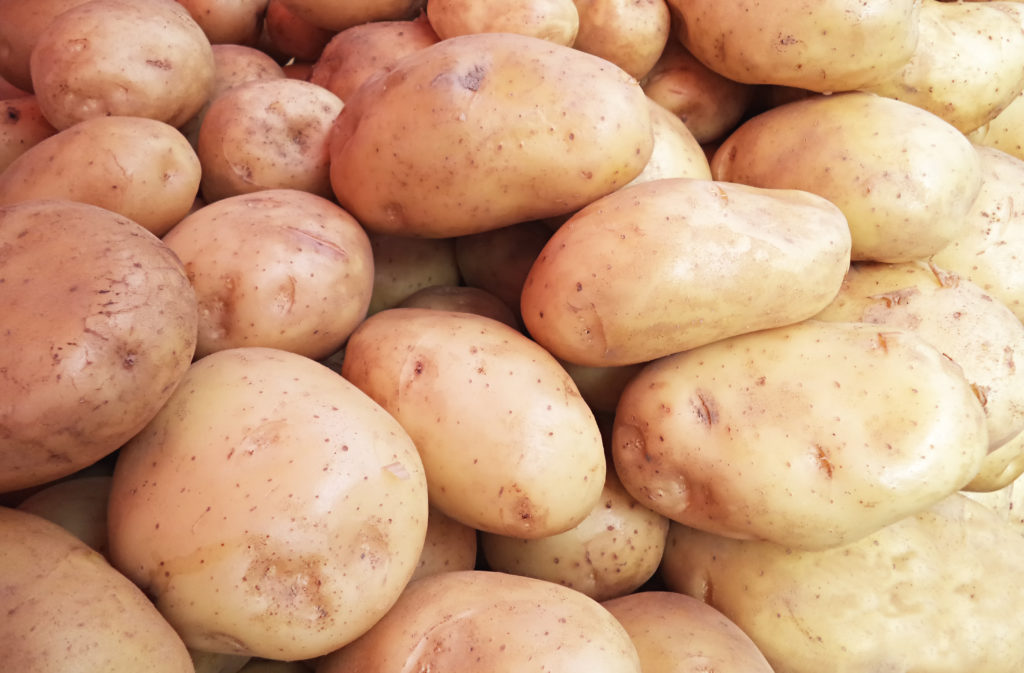
Timing of Soil Calcium Availability and Supply to Potatoes
{Sponsored} Calcium is a key nutrient for potato growth, quality and marketable yield. Ensuring tubers have access to enough calcium is trickier than it seems, especially during tuber initiation but also throughout the season.
Meeting peak demand timing for calcium is the key component to increasing tuber quality and minimizing shrinkage and other storage issues. Once tuber initiation begins, cell division inside the developing potato happens rapidly for about three weeks. The “cell-division window” is the only time when calcium gets incorporated into the tuber cells.
Once the cell-division window has passed, new vine growth will continue to require calcium. If it is not available, the vines will leach calcium from the tubers. Growers must keep a consistent supply available in the soil throughout the season in order to ensure proper growth in all parts of the plant.
“As the vine continues to grow, and every time there is a new shoot or leaf, that is cell division; the calcium uptake needs to continue for each of those new growths. If you do not support the calcium properly as vine grows, it will rob calcium from the tuber,” said Ken Dart, national technical manager of Agro-K Corporation.
Getting calcium into tubers can be challenging because potatoes only take up calcium through the stolon and the tuber root hairs. All calcium that moves via mass flow into the main root system is directed primarily to the growing points on the vine to support vegetative cell division.
Maximizing Calcium
To maximize calcium in the tuber, two things must occur before and during the cell division window.
First, calcium must be readily available in soil solution, which requires growers to manage their ground fertility effectively.
Second, the stolon and tuber root hairs must be operating at maximum efficiency. Manganese and zinc are key to root growth and health.
Sysstem-Ready™, from Agro-K, delivers these nutrients more effectively to the roots than competing foliar micronutrient formulations and is designed to maximize root growth, health, efficiency and calcium uptake.
Because potassium is so mobile in the plant and because it moves more quickly than calcium, potassium can block calcium incorporation into the cell wall during tuber cell division. The use of highly mobile potassium phosphite during cell division can reduce or prevent calcium uptake into the tuber, leading to lower tuber calcium levels at harvest, lower specific gravity and potential storage problems. “It is imperative that growers pay attention to calcium levels all season long to prevent inadvertent tuber deterioration,” Dart said.
How does Agro-K’s Sysstem-Ready phosphite technology work?
Root Flush Technology™ — Sysstem-Ready helps increase root mass and foraging capacity by enhancing the natural process that roots use to free-up and extract soil-bound nutrients. Increasing the natural “root flushing” activity allows the plant to extract more nutrients and moisture from the soil while also increasing the efficiency and effectiveness of soil-applied fertility programs. Applications of Sysstem-Ready at tuber initiation enhance the root flushing effect helping increase calcium uptake by the stolon and tuber root hairs. Tuber initiation is the start of cell division in the tuber, the key timing for getting calcium into the tuber, increasing specific gravity and producing quality potatoes.
Systemic Nutrition — nutrient-based phosphites are highly systemic; both phloem and xylem mobilize enhancing the efficiency and mobility of applied nutrients (Zn, Mn, Mg, etc.). Sysstem-Ready is a true phosphite-based micronutrient without potassium, helping move nutrients throughout the plant from the roots to the tubers to the growing vine tips to improve tuber growth and plant health. Most competing phosphite products are potassium phosphite or potassium phosphite based with chelated micronutrients blended in. Growers need to be mindful that “foliar” potassium applied during tuber cell division antagonizes calcium incorporation into the tuber and greatly increases the potential for calcium deficiency related issues in the tuber. Sysstem-Ready, because it is not potassium based, does not antagonize tuber calcium uptake early season and actually stimulates maximum calcium uptake.
Fastest Penetration and Uptake — the low pH zinc and manganese phosphite solution is rapidly absorbed by even the thickest and toughest leaf surfaces, making it the best choice to systemically deliver nutrients faster and more completely than other foliar formulations. Low pH formulations have significant advantages over neutral pH phosphite products — aiding in the uptake of other larger crop protection molecules that are often more difficult to get into the plant. In addition, low pH solutions improve compatibility and stability of most tank mixes without the extra expense of an acidifying agent/buffer. When leaf surface is dry it’s in!
Excellent Value
Sysstem-Ready provides more value to potato growers in one jug than any other competing foliar zinc and manganese micronutrient on the market. No other foliar micronutrient on the market gives growers a better way to supply the right nutrients at the right time, in the right form and in the right mix to impact tuber quality, yield potential and overall vine health.
For more information on Sysstem-Ready, visit https://www.agro-k.com/resources/increasing-marketable-potato-yield-and-internal-quality/
Sysstem is a trademark of Agro-K Corporation.
© 2019 Agro-K Corporation














